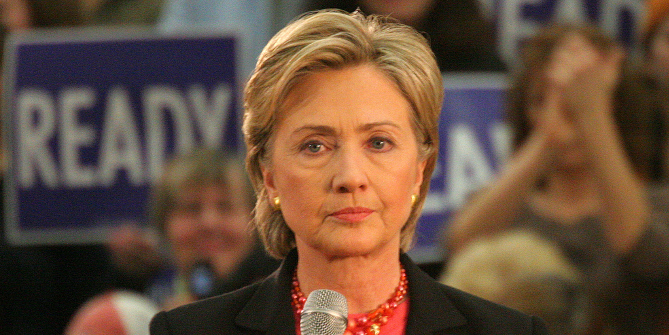

 Recent years have seen Republicans promote legislation to restrict teaching concepts about race, including Critical Race Theory (CRT). In new survey research, Allison Harell, Mia Carbone and Stuart Soroka examine how the teaching of race is framed in the classroom. By presenting respondents with various statements about how race is taught, including one which mentions CRT, they find that using the term can activate Republicans’ sense of partisanship and racial prejudices.
Recent years have seen Republicans promote legislation to restrict teaching concepts about race, including Critical Race Theory (CRT). In new survey research, Allison Harell, Mia Carbone and Stuart Soroka examine how the teaching of race is framed in the classroom. By presenting respondents with various statements about how race is taught, including one which mentions CRT, they find that using the term can activate Republicans’ sense of partisanship and racial prejudices.
In recent years, the debate around Critical Race Theory (CRT) has moved from academic circles into the public arena, becoming a wedge issue in American politics. But why has CRT become such a divisive topic? The answer is likely about framing: politicians have successfully used the term to rally their troops, and to connect partisan identities to political attitudes about race.
Despite its origin in the 1970s, and the decades of academic work on it since, CRT has only very recently exploded onto the political agenda. In the first half of 2021, for example, conservative Fox News mentioned CRT more than 2000 times in their broadcasts. At the same time, there was a concerted push by Republican lawmakers across restrict teaching about race in K-12 classrooms. For example, in 2022, Florida’s Republican governor Ron DeSantis signed into law the Individual Freedom Act (originally called the Stop Woke Act) which restricts the teaching of “divisive” concepts related to race. DeSantis is quoted as saying “in Florida we are taking a stand against the state-sanctioned racism that is critical race theory. We won’t allow Florida tax dollars to be spent teaching kids to hate our country or to hate each other.”
How CRT frames teaching race in the classroom
How does CRT frame the issue of teaching race in the classroom? In the study of law, CRT is a theory examining how laws and legal institutions perpetuate systemic racism. It argues that racism is not just a matter of individual prejudice but is embedded in legal systems and policies. Relatedly, in the study of education, research has developed around culturally relevant pedagogy: providing students with culturally-appropriate material, and also the critical thinking skills to question the inequities that schools and other institutions perpetuate.
Despite its academic origins, the term “CRT” has become a lightning rod for concerns about any teaching about race in schools. CRT, as it has recently been used in public discourse, tends to focus on two components that are simplified caricatures of its academic traditions: first, a recognition that institutions perpetuate discrimination and, perhaps most mobilized in current legislative efforts against CRT, a focus on how this discrimination has privileged white people in America.
Our new study suggests that the strategic use of this term by Republican lawmakers has made it a powerful tool for activating both political identities and deep-seated prejudices in the American public. In a survey of over 2,000 people fielded in 2021, we randomly assigned respondents to receive either a neutral question about teaching young people about “the history of race in this country,” or one of three alternative statements. The first simply mentioned “Critical Race Theory”, the buzzword dominating public debate. The two other statements focused on the key components of CRT in legislative efforts, “how American institutions perpetuate racial discrimination” and “how White people have been privileged and Black people discriminated against.”
We then asked respondents if they would support “teaching history in this way” in elementary schools, high schools, and in colleges and universities. We expected that CRT would activate partisan identities more than the neutral and descriptive primers. That is, we expected the CRT treatment to produce an especially large gap in policy support across Democrats and Republicans.

“3rd Floor Display – Critical Race Theory” (CC BY 2.0) by college.library
How policies are framed matters
Our findings do support the idea that Republicans in particular are sensitive to the statements relative to the neutral discussion of the history of race. Figure 1 below shows the average levels of support for policy (combining all three levels of education) for Democrats (gray) and Republicans (black), across all four statements put to survey respondents. Democrats show relatively high support across all conditions. Republicans show middling levels of support, even for the “History” statement, and markedly lower levels of support for the others. Note that this occurred even without any explicit mention of partisanship in the statements received by survey participants.
Figure 1 – Policy support and partisanship across

Why? One mechanism driving a decrease in support is that the CRT frame more effectively engages racial attitudes (measured and analyzed in the study using a standard “symbolic racism” scale) than the neutral framing of the history of race. That said, the CRT treatment is not unique in this regard. Both the Discrimination and Privilege statements have a similar impact on attitudes.
Our inference from these results is that the words used in policy debates matter, perhaps quite a lot, especially when they make it onto the public’s radar. The words used in discussing CRT are more than just different ways of describing the teaching of history and race—they are powerful tools that can mobilize political identities and evoke, implicitly rather than explicitly, deep-seated prejudices. Understanding these dynamics is crucial for navigating today’s complex landscape of race and politics in America. While CRT may have fallen off the radar in recent months, its power to shape policy preferences along partisan lines speaks to just how polarized US politics is today.
- This article is based on the paper: ‘Critical Race Theory: How Policy Language Differentially Engages Symbolic Racism and Partisanship’ in Perspectives on Politics
- Please read our comments policy before commenting.
- Note: This article gives the views of the author, and not the position of USAPP – American Politics and Policy, nor the London School of Economics.
- Shortened URL for this post: https://wp.me/p3I2YF-e39






